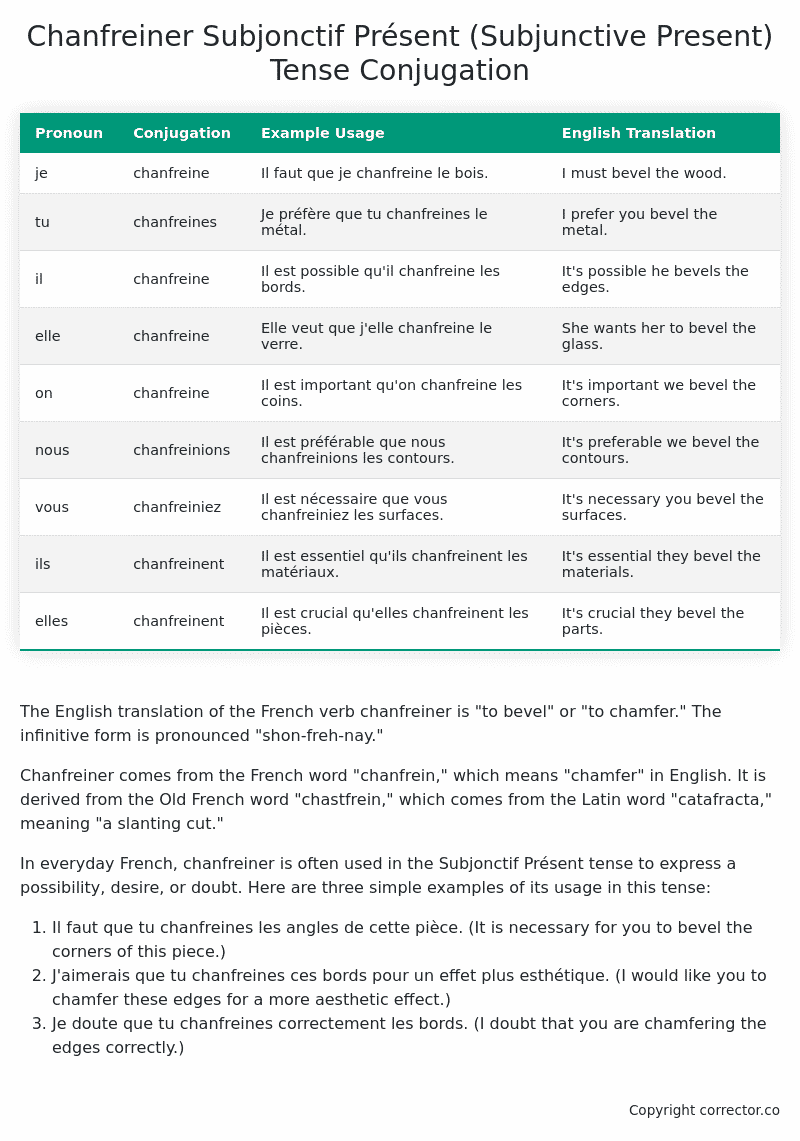Subjonctif Présent (Subjunctive Present) Tense Conjugation of the French Verb chanfreiner
Introduction to the verb chanfreiner
The English translation of the French verb chanfreiner is “to bevel” or “to chamfer.” The infinitive form is pronounced “shon-freh-nay.”
Chanfreiner comes from the French word “chanfrein,” which means “chamfer” in English. It is derived from the Old French word “chastfrein,” which comes from the Latin word “catafracta,” meaning “a slanting cut.”
In everyday French, chanfreiner is often used in the Subjonctif Présent tense to express a possibility, desire, or doubt. Here are three simple examples of its usage in this tense:
- Il faut que tu chanfreines les angles de cette pièce. (It is necessary for you to bevel the corners of this piece.)
- J’aimerais que tu chanfreines ces bords pour un effet plus esthétique. (I would like you to chamfer these edges for a more aesthetic effect.)
- Je doute que tu chanfreines correctement les bords. (I doubt that you are chamfering the edges correctly.)
Table of the Subjonctif Présent (Subjunctive Present) Tense Conjugation of chanfreiner
| Pronoun | Conjugation | Example Usage | English Translation |
|---|---|---|---|
| je | chanfreine | Il faut que je chanfreine le bois. | I must bevel the wood. |
| tu | chanfreines | Je préfère que tu chanfreines le métal. | I prefer you bevel the metal. |
| il | chanfreine | Il est possible qu’il chanfreine les bords. | It’s possible he bevels the edges. |
| elle | chanfreine | Elle veut que j’elle chanfreine le verre. | She wants her to bevel the glass. |
| on | chanfreine | Il est important qu’on chanfreine les coins. | It’s important we bevel the corners. |
| nous | chanfreinions | Il est préférable que nous chanfreinions les contours. | It’s preferable we bevel the contours. |
| vous | chanfreiniez | Il est nécessaire que vous chanfreiniez les surfaces. | It’s necessary you bevel the surfaces. |
| ils | chanfreinent | Il est essentiel qu’ils chanfreinent les matériaux. | It’s essential they bevel the materials. |
| elles | chanfreinent | Il est crucial qu’elles chanfreinent les pièces. | It’s crucial they bevel the parts. |
Other Conjugations for Chanfreiner.
Le Present (Present Tense) Conjugation of the French Verb chanfreiner
Imparfait (Imperfect) Tense Conjugation of the French Verb chanfreiner
Passé Simple (Simple Past) Tense Conjugation of the French Verb chanfreiner
Passé Composé (Present Perfect) Tense Conjugation of the French Verb chanfreiner
Futur Simple (Simple Future) Tense Conjugation of the French Verb chanfreiner
Futur Proche (Near Future) Tense Conjugation of the French Verb chanfreiner
Plus-que-parfait (Pluperfect) Tense Conjugation of the French Verb chanfreiner
Passé Antérieur (Past Anterior) Tense Conjugation of the French Verb chanfreiner
Futur Antérieur (Future Anterior) Tense Conjugation of the French Verb chanfreiner
Subjonctif Présent (Subjunctive Present) Tense Conjugation of the French Verb chanfreiner (this article)
Subjonctif Passé (Subjunctive Past) Tense Conjugation of the French Verb chanfreiner
Subjonctif Imparfait (Subjunctive Imperfect) Tense Conjugation of the French Verb chanfreiner
Conditionnel Présent (Conditional Present) Tense Conjugation of the French Verb chanfreiner
Conditionnel Passé (Conditional Past) Tense Conjugation of the French Verb chanfreiner
L’impératif Présent (Imperative Present) Tense Conjugation of the French Verb chanfreiner
L’infinitif Présent (Infinitive Present) Tense Conjugation of the French Verb chanfreiner
Struggling with French verbs or the language in general? Why not use our free French Grammar Checker – no registration required!
Get a FREE Download Study Sheet of this Conjugation 🔥
Simply right click the image below, click “save image” and get your free reference for the chanfreiner Subjonctif Présent tense conjugation!

Chanfreiner – About the French Subjonctif Présent (Subjunctive Present) Tense
Formation of the Subjonctif Présent
Common Everyday Usage Patterns
Interactions with Other Tenses
Summary
I hope you enjoyed this article on the verb chanfreiner. Still in a learning mood? Check out another TOTALLY random French verb conjugation!


